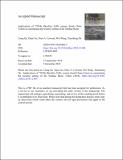Implications of 770 Ma Rhyolitic Tuffs, eastern South China Craton in constraining the tectonic setting of the Nanhua Basin
Abstract
Mid-Neoproterozoic magmatic rocks from the southeastern part of the Nanhua Basin constrain the tectonic setting of the basin. Data from rhyolitic tuffs of the Louqian Formation that overlie the Cathaysia Block in southeastern South China indicate accumulation of the unit at ca. 770 Ma, and provide an upper age limit on collisional assembly of the Yangtze and Cathaysia blocks. The zircons within the tuffs display largely positive εHf(t) (−3.66 to +13.94) and juvenile TDM (Hf) values (1.74–0.90 Ga), which indicate involvement of Neoproterozoic to late Paleoproterozoic crustal materials in their generation. Geochemically, the tuffs are peraluminous and characterized by both A-type and arc affinities with high SiO2, Ga, accentuated negative Eu anomalies, strong depletion in high field strength elements and high zircon saturation temperatures (TZr), which are comparable to contemporaneous (800–750 Ma) felsic rocks from the northwestern of the Nanhua Basin. These characteristics suggest the Nanhua Basin lay inboard of a convergent plate margin arc. This arc is represented by 860–730 Ma magmatism along the western and northern margin of the South China Craton (Panxi-Hannan Belt), with the Nanhua Basin occupying an upper plate, back arc setting.
Citation
Qi , L , Xu , Y , Cawood , P A , Wang , W & Du , Y 2019 , ' Implications of 770 Ma Rhyolitic Tuffs, eastern South China Craton in constraining the tectonic setting of the Nanhua Basin ' , Lithos , vol. 324-325 , pp. 842-858 . https://doi.org/10.1016/j.lithos.2018.12.004
Publication
Lithos
Status
Peer reviewed
ISSN
0024-4937Type
Journal article
Description
This work was supported by the National Natural Science Foundation of China (Grant No. 41772106 and 41472086) and by the Australian Research Council (Grant FL160100168).Collections
Items in the St Andrews Research Repository are protected by copyright, with all rights reserved, unless otherwise indicated.

